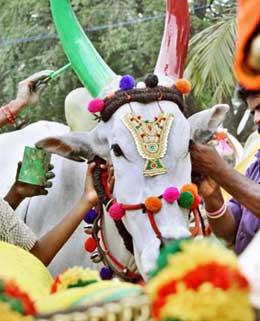Understanding Kanuma Festival in Andhra Pradesh: History, Significance, and Traditions

The Kanuma Festival, an important event in Andhra Pradesh, primarily celebrates cattle worship. It takes place on the third day of the state's harvest, Makar Sankranti Farmers hold this festival in high esteem, celebrating with significant fervour and enthusiasm. Hindu mythology imbues the day with particular importance; it commemorates the legendary event when Lord Krishna protected the inhabitants of Gokulam from a severe flood. Legend states that on this day, Lord Krishna persuaded the villagers to worship Govardhan Hill, which induced the rainfall they desperately needed. This action, however, provoked Lord Indra, the deity of rain, leading him to inundate the village with a violent storm as retribution. In response, Krishna safeguarded the villagers and their livestock by lifting the massive Govardhan Hill with a single finger, providing them shelter. Upon recognizing his error, Indra ceased the downpour.
To appease Indra further, Krishna initiated a Govardhan Puja. The Kanuma Festival has since been celebrated to honor this divine intervention. On this day, devoted to cattle reverence, farmers start their day early, bathing and adorning their cattle with ornaments and vividly painting their horns. Subsequently, the decorated cattle are taken to nearby temples for ritualistic worship. Another notable aspect of the Kanuma Festival includes bullfights and wagers on the animals.
Location:
Throughout Andhra Pradesh.
The month of Celebration:
The Kanuma Festival usually occurs in January.
FAQs:
What is the Kanuma Festival and why is it celebrated in Andhra Pradesh?
The Kanuma Festival is a significant event in Andhra Pradesh that celebrates cattle worship. It takes place on the third day of Makar Sankranti and honors the divine intervention of Lord Krishna, who protected the villagers and their cattle from a severe flood by lifting Govardhan Hill.
What is the historical and mythological significance of the Kanuma Festival?
The Kanuma Festival commemorates the event when Lord Krishna persuaded the villagers of Gokulam to worship Govardhan Hill, resulting in much-needed rainfall. This act angered Lord Indra, leading to a violent storm. Krishna then protected the villagers and their livestock by lifting Govardhan Hill, providing them shelter from the storm.
What are the main traditions and activities during the Kanuma Festival?
On Kanuma, farmers start their day early by bathing and adorning their cattle with ornaments and painting their horns. The decorated cattle are then taken to nearby temples for worship. The festival also features bullfights and wagers on the animals, showcasing the festive spirit and community participation.
When and where is the Kanuma Festival celebrated?
The Kanuma Festival is celebrated throughout Andhra Pradesh, usually in January, as part of the Makar Sankranti harvest festivities.
How does the Kanuma Festival reflect the agricultural and cultural heritage of Andhra Pradesh?
The Kanuma Festival highlights the vital role of cattle in agriculture, symbolizing prosperity and gratitude towards these animals. The festival also underscores the region's rich cultural heritage, with its blend of mythology, rituals, and community celebrations, strengthening the bond between farmers and their livestock.